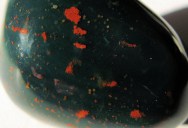What Is a Bloodstone Crystal and Why Do People Think It’s Special?
If you’re someone who is into alternative medicine and new age health practices, there’s a good chance a crystal or two are hanging out around your house.
If you’ve got a bloodstone crystal, you probably know people attribute many qualities to the stone – but you might not know that at least one of them might turn out to be true.

Image Credit: Creative Commons
Bloodstone is actually the mineral heliotrope, a type of quartz that has been prized since Roman times. It’s mostly green but has small red spots, the latter of which giving the stone its popular nickname.
Before early Christians began to associate the red spots with drops of Christ’s blood, Pliny the Elder believed it had magical powers.
“When the stone is dropped into a vessel of water and bright sunshine falls upon it, in reflecting the sunlight it changes it into the color of blood. This is true especially of the Ethiopian variety.”
This is, of course, easily refuted, though Pliny never felt the need to test the theory for himself.

Image Credit: Public Domain
Heliotrope plants get their name from the way the flowers follow the sun during the day, and Pliny was sure he knew why the stone was named after them.
“The same stone catches the sunlight like a mirror and detects solar eclipses, showing the passage of the moon below the sun’s disc.”
Not that you’d need a stone to inform you of a solar eclipse, but sure.
The Aztecs ascribed similar properties to the stone, and hematite may have had astringent effects that help stem blood loss, so that claim wasn’t total baloney.

Image Credit: Creative Commons
Modern crystal healers claim bloodstone can be used to improve focus and strengthen decision-making, and obviously there’s less evidence that’s true in any sense of the claim.
You don’t have to believe the stone can do anything but look pretty in order to appreciate or even collect it, though the purported “extra” benefits it offers do tend to drive up the price online.

Sign up to get our BEST stories of the week straight to your inbox.




